
When can baby sit in stroller without additional support around 4 to 6 months of age. At this stage, most babies have developed enough neck and head control to sit upright for short periods.
However, the exact timing may vary depending on the baby’s physical development and the type of stroller being used.
For younger infants, especially those under 6 months, it’s best to use a stroller with a fully reclining seat or one compatible with a car seat attachment. These features ensure proper support for their delicate spine and neck muscles.
Once the baby can sit up independently, usually around 6 months, a standard upright stroller becomes more suitable. Parents should always refer to the manufacturer’s guidelines and consider their baby’s comfort and safety when deciding.
If you’re uncertain about your baby’s readiness, consulting a pediatrician is a wise step to ensure you make the safest choice.
What Type of Stroller Can a Newborn Use?
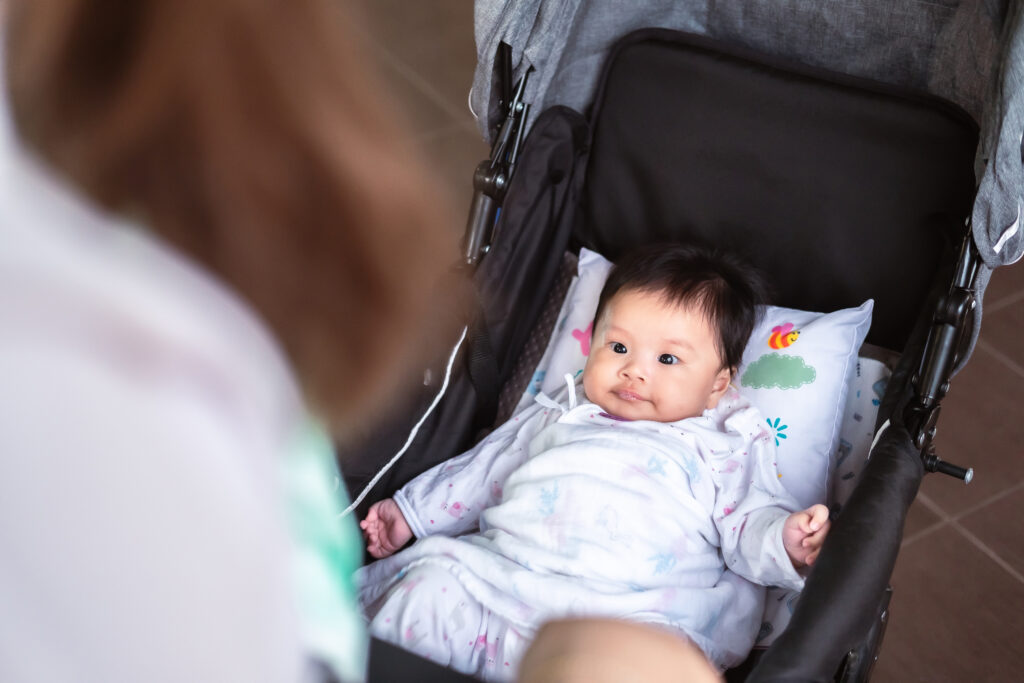
Newborns need strollers that prioritize safety and support to accommodate their developing bodies. Since they cannot sit up or control their head and neck, choosing the right stroller is essential for their comfort and health.
Fully Reclining Strollers
Fully reclining strollers are a top choice for newborns. These models allow babies to lie flat, crucial for their spine development and proper breathing. Reclining seats that adjust as your baby grows make these strollers a versatile option.
Bassinet Strollers
Bassinet strollers are specifically designed for newborns. They provide a flat, cradle-like surface that mimics a crib, making them ideal for long walks or naps on the go. These strollers offer a cozy, secure environment for your baby’s early months.
Travel System Strollers
A travel system includes a stroller frame that accommodates an infant car seat. This setup is convenient for families on the move, allowing seamless transitions between the car and stroller without waking the baby.
Convertible Strollers
Convertible strollers grow with your baby, featuring multiple configurations. For newborns, they include reclining seats or bassinet attachments.
As your baby develops, these strollers adapt to suit their needs, making them a cost-effective choice.
Features to Look For
Reclining Seat or Bassinet: Ensures a flat or nearly flat position for safe, comfortable rides.
5-Point Harness: Keeps your baby secure during outings.
Padding and Support: Soft materials to protect your baby’s delicate body.
Good Suspension: Reduces jolts on uneven surfaces for a smooth ride.
Sun Protection: A large canopy to shield your newborn from harsh sunlight.
When To Put Your Baby In A Stroller
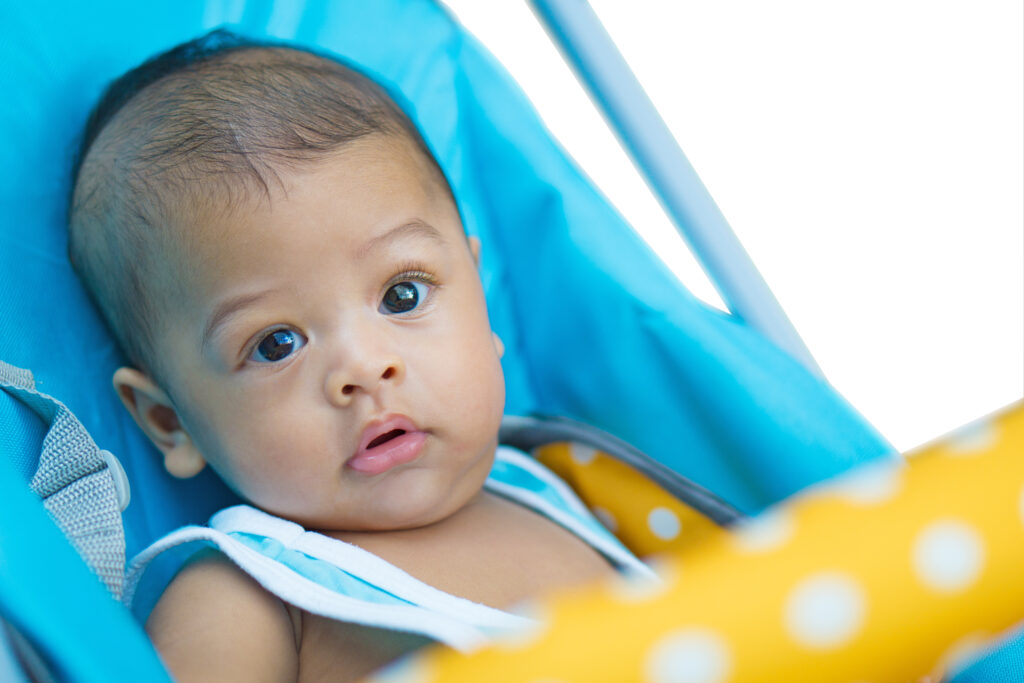
Introducing your baby to a stroller is an exciting milestone, and the timing depends on their age, developmental stage, and the type of stroller. Here’s a comprehensive guide to help you make the safest and most comfortable choice:
Right From Birth
You can put your newborn in a stroller immediately after birth, provided it is designed for newborns. Options like fully reclining strollers, bassinet strollers, or travel systems
with infant car seats are ideal for supporting a newborn’s delicate neck and spine. These strollers allow your baby to lie flat, ensuring proper alignment and breathing.
4 to 6 Months: Semi-Reclined Strollers
As your baby develops stronger head and neck control, usually between 4 to 6 months, they can transition to a semi-reclined stroller seat. These strollers still offer support but allow your baby to sit at a slight angle, giving them a better view of their surroundings while maintaining comfort and safety.
6 Months and Beyond Upright Strollers
By 6 months, most babies can sit up independently. At this stage, they’re ready for a traditional upright stroller. These strollers are more interactive, enabling your baby to explore their environment more actively.
Many upright strollers also feature adjustable seats that can still recline for naps during outings.
Key Considerations for Choosing the Right Time
Developmental Readiness: Ensure your baby has the necessary head, neck, and upper body control before transitioning to semi-reclined or upright strollers.
Stroller Type: Choose a stroller that matches your baby’s age and stage, ensuring proper support and safety features.
Safety First: Look for a stroller with a secure 5-point harness, good suspension, and adequate padding.
Comfort: Consider strollers with adjustable seats, smooth wheels, and sunshades for added comfort.
When Can Baby Sit in Stroller Without a Car Seat?
Knowing when to transition your baby from using a car seat in a stroller to sitting directly in the stroller seat is crucial for both safety and comfort. This decision largely depends on your baby’s physical development and the type of stroller you’re using.
Developmental Milestones for Sitting Without a Car Seat
Babies generally reach the developmental stage where they can sit in a stroller without a car seat between 6 and 9 months. The exact timing varies by baby, but there are a few key milestones to look for:
Strong Head and Neck Control: Babies should have enough neck and head control to sit upright in a stroller. This typically develops in 4 to 6 months.
Independent Sitting Ability: Around 6 months, many babies can sit up without support, which is a sign they’re ready for a more upright stroller position.
Core Strength: The baby needs sufficient core strength to maintain stability while seated. This ability often becomes more pronounced between 6 to 9 months.
Types Of When Can Baby Sit in Stroller
Once your baby has the strength and control to sit up independently, they are ready for a standard stroller without a car seat. Here are some stroller options that work well as your baby transitions:
Standard Upright Strollers: These are the most common strollers for babies who can sit independently. They feature more upright seating and allow your baby to interact with their environment, which is great for development.
Safety Considerations
Always follow the stroller’s guidelines for age and weight limits.
Ensure the stroller has a 5-point harness system to keep your baby securely in place.
Consider a stroller with good suspension to ensure a smooth ride for your baby, especially on uneven surfaces.
Keeping Your Baby Safe in a Stroller
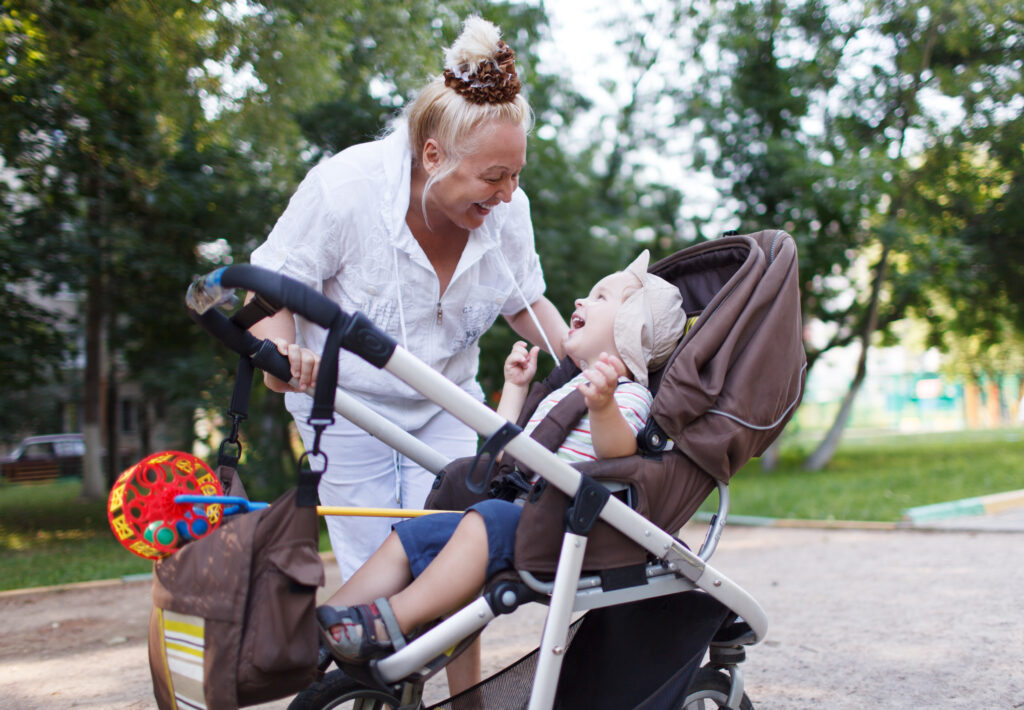
Ensuring your baby’s safety while using a stroller is crucial for every outing. A stroller provides a great way to explore the world, but it also requires constant attention to safety features to protect your baby from potential hazards. Here’s how to keep your baby safe in a stroller.
Use a Secure 5-Point Harness.
One of the most important safety features of any stroller is a secure 5-point harness. This harness system includes straps that secure your baby’s shoulders, waist,
and between the legs, keeping them firmly in place and preventing them from slipping or falling out. Always ensure the harness is snug, but not too tight, and adjust it as your baby grows.
Keep the Stroller Brakes Engaged
Always lock the stroller’s brakes when it’s stationary. This is especially important when you’re stopped on an incline or uneven surface. Engaging the brakes prevents the stroller from rolling away and ensures your baby is safe and stationary. Make sure you test the brakes before use to ensure they’re functioning properly.
Supervise Your Baby at All Times
Even if your stroller has all the necessary safety features, it’s important to supervise your baby at all times. Babies can move quickly or unexpectedly, so make sure you’re always paying attention. When stopped, never turn your back on the stroller.
Check the Stroller for Stability
Before using the stroller, give it a quick inspection. Check for any loose parts, worn-out wheels, or faulty brakes. Ensure that the stroller is stable and functioning correctly. If your stroller has an adjustable recline feature, make sure the seat is securely locked in place.
Be Mindful of the Weather
Protect your baby from extreme weather conditions. Use a stroller with a sunshade to shield your baby from the sun, and consider additional weather protection like a rain cover or blanket for colder weather. Always check the stroller for ventilation to avoid overheating on warm days.
Oh, Baby, You’re Ready to Roll!

Congratulations, your little one is growing fast, and the time has come to take those first adventures in a stroller! Whether you’re heading out for a stroll around the block, a trip to the park, or a family outing, it’s an exciting milestone.
But before you hit the pavement, there are a few things to keep in mind to ensure your baby’s ride is as safe and comfortable as possible.
Selecting the Right Stroller
The first step in getting your baby ready to roll is choosing the right stroller. At this stage, your baby should have the right head and neck control to sit up independently or at least be able to recline comfortably in a fully reclining stroller.
If they’re still a bit wobbly in the sitting department, make sure you choose a stroller that offers extra support for their growing body, like a bassinet or fully adjustable recline feature.
Harnessing the Adventure
Once you’ve got the perfect stroller, make sure your baby is secure with a 5-point harness. This is crucial for keeping your baby snug and preventing any unexpected wiggles
that could lead to slips or falls. A properly adjusted harness ensures your baby is safely in place, no matter how bumpy the ride gets!
Ready to Roll
With the right stroller and safety precautions in place, you and your baby are ready to roll! Whether it’s a short stroll or a long outing, enjoy these precious moments together while exploring the world around you.
How to Check Postural Control

Postural control refers to a baby’s ability to maintain their body position and balance in different environments. It’s an essential developmental milestone that ensures babies can sit, stand, and eventually walk.
Checking postural control is important for understanding your baby’s development and knowing when they’re ready for activities like sitting in a stroller without extra support. Here’s how to assess your baby’s postural control.
Head Control
One of the first signs of developing postural control is the ability to hold their head up.
Newborn to 2 months: Babies have very little head control and will need support, especially when held upright or in a seated position.
Around 3 to 4 months: Babies start to gain better head control and can briefly hold their head steady when held upright.
Around 6 months: Strong head control is typically developed, and babies can hold their heads steady in most positions.
Trunk Control
The ability to control the torso and maintain balance when seated or during movements is another important aspect of postural control.
Around 4 to 5 months: Your baby may begin to sit with support, such as holding onto a caregiver’s hands or propped by pillows
Around 6 months: Many babies can sit upright with little support for short periods, and their trunks remain stable without slouching.
By 9 months: Strong trunk control allows babies to sit unsupported and adjust their body position to maintain balance.
Sitting Balance
Assessing how well your baby sits is a good indicator of their postural control.
Before 4 months: Babies can’t sit unsupported and require external support, like a caregiver or a seat.
By 4 to 6 months: Babies start to sit with support, such as leaning against a cushion or with their hands propped forward.
At 6 months: Babies are often able to sit without support for short durations, but they may still topple if they reach out too far.
By 9 months: Most babies can sit upright without support for extended periods and shift their weight to reach for objects.
Tummy Time
Tummy time is crucial for building postural control in early development.
From birth: Newborns should be placed on their tummy several times a day to strengthen the neck, back, and shoulder muscles.
Around 3 months: Babies can hold their heads up during tummy time for longer periods.
Around 6 months: Babies can push up onto their arms and may begin to roll over or support themselves in a crawling position.
Standing and Weight Shifting
As babies near their first year, they begin to develop the ability to support their weight and balance.
Around 8 to 9 months: Babies can start to bear weight on their legs when held upright and may try standing with support.
By 12 months: Some babies can stand independently and start shifting their weight from one leg to the other, a precursor to walking.
What to Watch For
While every baby develops at their own pace, if your baby is significantly delayed in any of these areas, it could indicate a delay in their postural control.
If you’re concerned, consulting a pediatrician or a physical therapist can help identify whether your baby’s motor development is on track or if additional support is needed.
Key Considerations When Picking a Stroller for Your Baby
Choosing the right stroller for your baby is an important decision that can impact both your baby’s safety and your convenience.
With so many options available, it’s essential to consider a few key factors to ensure that you pick the best stroller for your family’s needs. Here are the most important considerations when selecting a stroller.
Safety Features
Safety is always the top priority when choosing a stroller. Look for the following safety features:
5-point harness system: Keeps your baby securely in place.
Brake system: Ensure that the stroller has reliable brakes that can lock securely when stationary.
Safety straps and padded restraints: Offer extra security for your baby.
Sturdy frame: A stable, durable frame ensures the stroller won’t tip over easily.
Comfort and Support
Your baby will spend time in the stroller, so comfort is crucial. Consider these factors:
Padding and cushioning: A well-padded seat ensures your baby is comfortable for longer outings.
Recline options: Adjustable recline features allow your baby to lie back for naps, providing better neck and back support.
Canopy and sun protection: A large canopy offers protection from the sun, and additional features like UV protection are beneficial in hot weather.
Stroller Size and Weight
If you live in a city or frequently use public transportation, a lightweight, compact stroller is ideal for easy maneuverability and storage. If you’re a parent who enjoys outdoor activities, a larger, all-terrain stroller may be better suited to rough paths and longer walks.
Budget
Strollers come in a wide range of prices, from budget-friendly options to high-end models. While it’s tempting to go for the most expensive stroller with all the bells and whistles,
it’s more important to focus on your family’s needs. Make sure you choose a stroller that provides the best balance of safety, comfort, durability, and features within your budget.
Stroller Safety Tips

Ensuring your baby’s safety while using a stroller is essential for both short walks and longer outings. Here are some important stroller safety tips to keep in mind:
Always Use the Harness
Always secure your baby with a 5-point harness. This ensures your baby is safely strapped in and reduces the risk of them slipping or falling out.
Never Leave Your Baby Unattended
Never leave your baby alone in the stroller, even for a few moments. A stroller can tip over, or your baby could be at risk in an unsafe environment.
Avoid Hanging Bags on the Handle
Hanging heavy bags or items from the stroller handle can affect its stability, potentially causing it to tip over. Always store items in the designated storage area under the stroller.
Use the Stroller on Safe Surfaces
Avoid using the stroller on steep inclines, rough terrain, or near traffic. Opt for smooth sidewalks or paths to minimize the risk of tipping.
Keep the Stroller Away from Moving Vehicles
When not in use, always keep the stroller a safe distance from parked or moving vehicles. Never leave your baby unattended near a car or other moving objects.
Use Sun Protection
Ensure your baby is protected from the sun by using a stroller with a large canopy or sunshade. Apply sunscreen and dress your baby appropriately for the weather.
Be Mindful of Your Surroundings
When pushing the stroller, stay alert to your surroundings, especially when navigating crowded areas or crossing streets. Always keep an eye on your baby and avoid distractions.
By following these stroller safety tips, you can ensure your baby stays safe and comfortable while enjoying outings together.
Final Thoughts on When Babies Can Sit in Strollers
Understanding when your baby is ready to sit in a stroller is crucial to ensure both their safety and comfort. Here are some additional insights to consider:
Developmental Readiness: Babies usually reach the ability to sit in a stroller without extra support between 6 to 9 months, once they can sit upright unassisted. Before this, it’s important to use a stroller with a reclinable seat or one that allows you to securely attach an infant car seat.
Postural Control: Good postural control is essential before sitting in an upright position in a stroller. At first, babies need the ability to hold their heads steady and maintain a strong trunk to avoid strain or discomfort.
Safety Considerations: Once your baby is ready to sit, always use the 5-point harness to secure them properly. This safety feature prevents your baby from sliding out, especially during movement or when the stroller is on uneven terrain.
Travel Systems: For parents with newborns, a travel system (stroller and infant car seat combo) can be a convenient solution. It allows your baby to stay in a familiar, supportive car seat, which can easily click into the stroller frame without disturbing them.
In conclusion, while the right time for your baby to sit in a stroller depends on their physical development, using the proper stroller with safety features and comfort options will ensure a smooth transition.
FAQs
Yes, but it’s important to choose a stroller that offers full reclining or is compatible with an infant car seat to provide adequate head and neck support. Newborns should not sit upright in a stroller until they have developed postural control.
If your baby cannot sit on their own, you should use a stroller that allows them to lie flat or be in a semi-reclined position to ensure proper support. Avoid using an upright stroller seat until your baby has the necessary head and neck control.
Yes, it’s generally safe for babies to nap in a stroller, provided it’s in a fully reclining position for younger infants. Make sure to follow safety guidelines, such as using the 5-point harness and keeping your baby’s head properly supported.
Yes, once your baby is able to sit up with support, you can use a stroller without a car seat. Just make sure the stroller provides enough head and body support with an adjustable recline or upright seat suitable for their age and development.
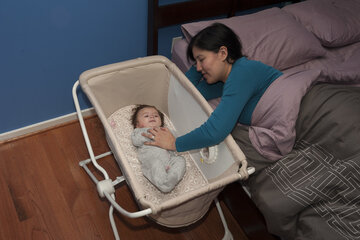
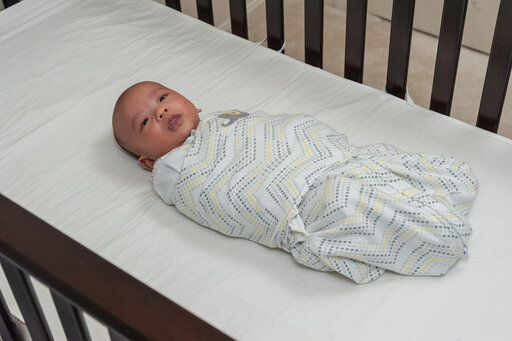
Leave a Comment